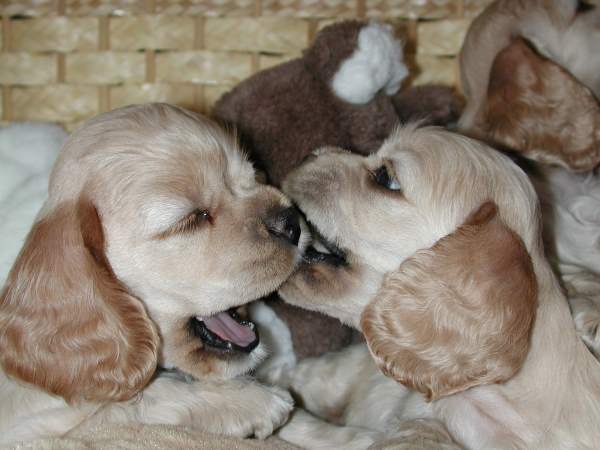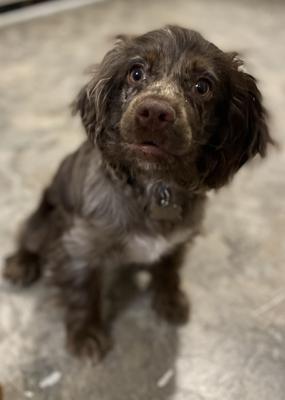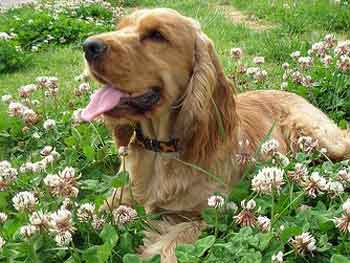- Home
- Cocker Spaniel Puppy Care
- Separation anxiety in puppies
Separation Anxiety in Puppies: Learn the Symptoms and How to Prevent It!
Separation anxiety in puppies is relatively common and can be upsetting to see it, as well as stressful for your puppy. The good news is that you can do something about it by helping your puppy feel more comfortable when left home alone.
Understand more about separation distress; learn how to diagnose it and what you can do to help your puppy get over his nervousness.
What Is Puppy Separation Anxiety?
Puppy and dog separation anxiety is quite common.
It's a real fear of being left alone, of being separated from the family, the pack, and when your puppy sees you getting ready to leave the house, it can send your pet into panic mode.
The good news, however, is that you can do something about it to help your puppy feel a little more confident about being left on his own.
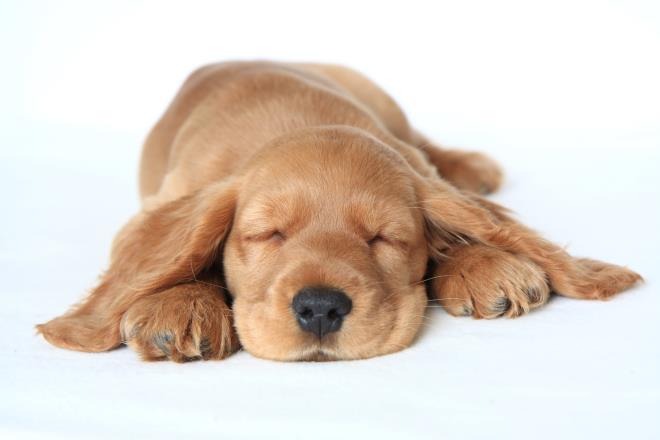 What is separation anxiety in puppies?
What is separation anxiety in puppies?Puppies enjoy the psychological and physical comfort of belonging to and interacting with a pack. They often attach themselves to one person, probably you, if you're his primary carer.
He may follow you around the house, from one room to the next (yes, even to the bathroom!) and rarely leave your side.
When Max was a little puppy, he would sit outside the bathroom door and cry until I'd open the door - there was no escaping from him! It was rather pathetic really; however, he was so bloomin' cute and adorable that I forgave him.
He's much older now, and I can safely leave him on his own for up to 8 hours, and he's fine. Admittedly, I don't do that very often, but there have been times when there was no other option.
This page will explain how to recognise the symptoms of separation anxiety in puppies so you can be sure you're treating the correct behaviour. It will also explain how to prevent your puppy from becoming distressed in your absence and what you can do to ease it.
What are the Signs of Separation Anxiety in Puppies?
All puppies show signs of separation distress in varying degrees.
When left alone, our pets can become nervous, stressed and insecure. However, as they get older and experience more socialisation and contact with other dogs and humans, they usually begin to feel more and more confident about being left to their own devices.
Sadly, not all dogs reach this calm stage; some will never be comfortable being alone.
Signs that your puppy has separation anxiety are as follows:
- Before you leave your home (and trust me, he'll recognise the signs), your puppy may become quite clingy and not want to leave your side (more than usual!).
- While you're out and your Cocker puppy has to cope without you, his anxiety may result in behaviours such as chewing, howling, barking, yelping, digging, pacing, panting or whining.
- In worse cases, he may forget his toilet manners and poop or pee indoors, scratch at the door, or become somewhat destructive, chewing carpets, raiding the trash, etc.
- Other, more severe behaviours include hyperactivity or depression, vomiting, and diarrhoea. It's also not unheard of that some adult dogs become aggressive to their owners to stop them from leaving, so intense is their panic about being left alone.
- A stressed puppy may lose his appetite or go the other way and over-eat (given the opportunity), so be warned, lock all food out of reach!
At this point, I'd like to emphasise that dog and puppy separation anxiety is not the same as boredom. However, boredom can result in similar behaviours such as chewing, pawing, digging, etc.
Separation anxiety begins just before or as soon as you leave the house, whereas boredom doesn't usually kick in until they've been alone for an hour or so.
Keeping your puppy occupied for that first hour may help him to relax and overcome his anxiety.
If your Cocker puppy follows you around all day, I recommend you do something about it now. Teach your pup to be more independent; otherwise, you'll end up with one anxious dog when you need to leave the house!
How To Prevent Separation Anxiety In Puppies
To prevent puppy separation anxiety arising in the first place, I recommend from day one that you begin to train your puppy to be comfortable and happy when left on his own for some or part of the day.
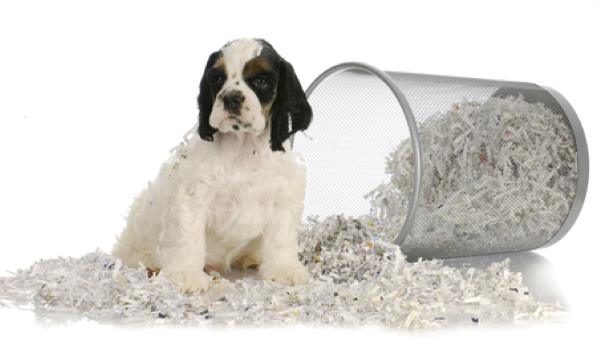 I was bored Mum!
I was bored Mum!To prevent puppy separation anxiety from arising in the first place, I recommend that, from day one, you begin to train your puppy to be comfortable and happy when left on his own for some or part of the day.
Teach him to be a little more independent.
- Use a room he can't 'destroy', such as a kitchen, utility room, or bathroom. If your puppy has any little accidents, you can clean them up quickly and easily. Remember to make sure the room is puppy-proof.
- Sit on the floor with your puppy and give him some toys to play with.
- When he begins playing, get up quietly, without fuss, and leave the room.
- Return in 1 minute and act like you've never been away.
- If your pup is playing quietly, give him a treat and a pat and leave him again, this time for a few minutes longer.
- If he comes running to you, all excited, little tail wagging, ignore him. He may be over-excited to see you, bark, jump up or run around wildly. Ignore him. I know it's not easy to ignore a cute little puppy who's pleased to see you, and you'll desperately want to pick him up and cuddle him, but don't.
- If you ignore your puppy until he's calm and has settled down, the message you're giving him, and which he'll come to learn, is that leaving him alone is no big deal.
Don't worry; there will be plenty of other times for cuddles!
As you practice daily, move around the house as you would normally.
If he gets up to follow you, take him back to where you left him and return to what you were doing.
If he barks while you're out of the room, don't return until he's quiet (a ten-second break from barking will do); otherwise, your puppy will learn that his noisy barking will get him what he wants. That's not a message you want to be giving him!
Practice leaving your puppy on his own often and gradually build up to more extended periods. I promise you; he'll soon get the message!
Tips To Help Ease Separation Anxiety in Puppies and Dogs
If your pet becomes destructive as a result of his puppy separation anxiety, it's important not to punish him.
Your puppy isn't misbehaving; it's not a training issue. Your Cocker is simply responding to his fear of being left alone.
Next time, before you leave the house, try the following steps; they will help to ease your pup's anxiety.
1. Tire Him Out!
Before you leave your puppy for any length of time, there are some things you can do to help prevent separation anxiety in puppies.
One of them is ensuring your dog is tired, so tire him out!
You can take him for a walk, play with him, or do a few training exercises to use up some of his excess or nervous energy. Your puppy is much more likely to fall asleep if he's tired. If he's sleeping, he's less likely to feel anxious while you're gone.
Keep puppy separation anxiety at bay by ensuring he's dog-tired (sorry for the pun!).
2. Feed Your Puppy Before You Leave
If the timing is right, or you can bring your puppy's mealtime forward a little, why not feed him as you leave? If he's busy eating, he may not notice you leaving, and if your puppy has a full tummy, he's more likely to fall asleep, contented, while you're away.
If you prefer not to feed him, or the timing isn't right, you could leave a couple of treats (such as liver nibbles or kibble biscuits) either in his crate or scattered around the kitchen for him to sniff out. Hiding little treats for your puppy to find will help him associate nice things with your leaving.
3. Keep Your Puppy Occupied!
If your Cocker Spaniel is bored, there's a good chance he'll become destructive.
To avoid this, try leaving your puppy a selection of safe toys to keep him occupied. A good selection of exciting toys to play with will help prevent separation anxiety in dogs.
The toys you give your Cocker to keep him occupied while you're away should be interesting and exciting and used only when you leave him alone to avoid him becoming bored with his toys.
When you return home, take the toys from him and put them away for another time to keep them 'fresh' and exciting; only let him have them when you go out.
You can also rotate his toys regularly to help prevent your puppy from becoming bored with them.
Puppies Love Kongs!
Kongs are great for helping to reduce separation anxiety in puppies and dogs.
Whenever you give your puppy treats, don't forget to offset them against his daily food allowance; otherwise, you'll end up with a fat Cocker Spaniel!
They're strong, almost indestructible chew toys that you stuff with tit-bits of your pet's favourite foods such as sausage, liver, hot dogs, treats and kibble and then seal either end with a bit of peanut butter.
You can freeze them to last longer too!
A stuffed Kong or two will undoubtedly keep your Cocker out of mischief for a while, keeping any problems associated with your dog's separation anxiety to a minimum.
I sometimes leave Max with an empty crisp packet (salt wiped clean) with a small teaspoon of peanut butter smeared inside. Watching him try to clean out the inside of the crisp packet is fun to watch, and it keeps him busy for ages!
Music Can Have A Calming Influence On Your Puppy
You could leave the radio on to keep him company. Leave it on either a chat show or an easy-listening channel, but keep it low-key, which will help keep him calm and relaxed.
The radio will also help reduce any external noises that may have startled or frightened him or triggered his barking.
Alternatively, leave this YouTube video running in the background. It's relaxing music, especially for puppies and dogs. It works for me!
4. Don't Make A Fuss When You Leave
When leaving the house without your puppy, it's best not to make a fuss; don't say goodbye or look at or pet him. Just go! Better still, try to leave without him knowing.
If you really can't resist it and feel the need to 'appease your guilt', say goodbye about fifteen minutes before you leave.
The more you fuss over him before you leave, the more anxious he will become.
Think about it.
You fuss over him, cuddle him, give him a treat and more cuddles (we do this to make ourselves feel less guilty about leaving him), and then we suddenly disappear, leaving him all alone. By which time, he's probably so wound up and raring to go, and that's when the trouble starts; chewing, biting, and getting into all sorts of mischief and, sometimes, destruction.
It is essential that your pet is calm and relaxed, possibly tired (read happy and contented) when you leave, not stressed or anxious.
The triggers that often set off separation anxiety in puppies and dogs are, for example, picking up your keys, mobile, handbag, coat, etc., and other little things you do before leaving the house, such as putting on your shoes or closing windows.
These predictable actions will let your puppy know that you're about to leave, and he'll immediately become anxious and begin to fret.
You can help to desensitize puppy's separation anxiety triggers by repeating them often but without leaving the house.
- For example, put your coat on and take it off several times.
- Pick up your house keys a few times without leaving and locking the front door. Put your keys in your pocket.
If your dog remains calm when you do any of these, praise him and treat him.
Try repeating this with other triggers until he's wondering whether you're going out or staying in. Removing the clues to these triggers will help to keep him calm.
If Your Puppy Has Separation Anxiety, Crating Can Help
Crating can help to reduce separation anxiety in puppies as their crate can make them feel safe and relaxed, which is one of the many benefits of crating your puppy.
If you haven't yet done so, I recommend you teach your pup the down and stay commands. Not only will these commands help you with your training sessions and in many situations when you're out and about, but lying down can have a calming effect on your puppy.
Use the command before you leave the room for a minute or two, and praise him if he's still in the same position when you return.
By practising and following the tips on this page, your Cocker will become more relaxed and calm, and any signs of puppy separation anxiety should become almost non-existent.
Photo Credits for Separation Anxiety in Puppies:
1. Poutnik at https://www.istockphoto.com/photo/english-cocker-spaniel-gm146866959-8739583
2. Willee Cole at https://stock.adobe.com/fr/images/puppy-sitting-in-recycled-paper/36318745




